Related Research Articles

George Pérez was an American comic book artist and writer, who worked primarily as a penciller. He came to prominence in the 1970s penciling Fantastic Four and The Avengers for Marvel Comics. In the 1980s he penciled The New Teen Titans, which became one of DC Comics' top-selling series. He penciled DC's landmark limited series Crisis on Infinite Earths, followed by relaunching Wonder Woman as both writer and penciller for the rebooted series. In the meantime, he worked on other comics published by Marvel, DC, and other companies into the 2010s. He was known for his detailed and realistic rendering, and his facility with complex crowd scenes.
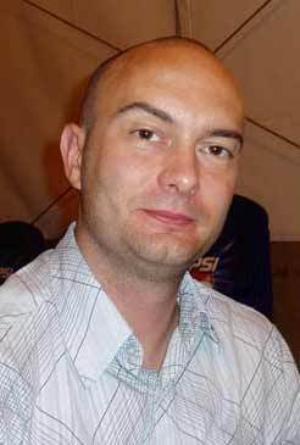
Gary Frank is a British comics artist, notable for pencilling on Midnight Nation and Supreme Power, both written by J. Michael Straczynski. He has also worked with author Peter David on The Incredible Hulk and Supergirl. He had a creator-owned series, Kin, which he wrote himself, published by Top Cow Productions in 2000.

Mark Farmer is a British comic book artist. He is best known as an inker, often working with Alan Davis.

Mark Bagley is an American comics artist. He has worked for Marvel Comics on such titles as The Amazing Spider-Man, Thunderbolts, New Warriors, Venom and Ultimate Spider-Man and for DC Comics on Justice League of America, Batman, and Trinity.

Ultimate Marvel, later known as Ultimate Comics, was an imprint of comic books published by Marvel Comics, featuring reimagined and modernized versions of the company's superhero characters from the Ultimate Marvel Universe, later known as the Ultimate Universe. Those characters include Spider-Man, the X-Men, the Ultimates, the Fantastic Four, and others. The imprint was launched in 2000 with the publication of the series Ultimate Spider-Man and Ultimate X-Men in 2001, followed by The Ultimates and Ultimate Fantastic Four in 2002 and 2004 respectively providing new origin stories for the characters. The reality of Ultimate Marvel is designated as Earth-1610 as part of the Marvel Comics Multiverse.
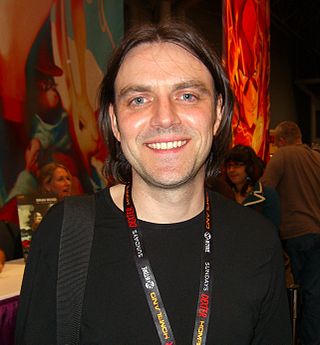
Vincent Patrick Deighan, better known by the pen name Frank Quitely, is a Scottish comic book artist. He is best known for his frequent collaborations with Grant Morrison on titles such as New X-Men, We3, All-Star Superman, and Batman and Robin, as well as his work with Mark Millar on The Authority and Jupiter's Legacy.

Nelson Alexander Ross is an American comic book writer and artist known primarily for his painted interiors, covers, and design work. He first became known with the 1994 miniseries Marvels, on which he collaborated with writer Kurt Busiek for Marvel Comics. He has since done a variety of projects for both Marvel and DC Comics, such as the 1996 miniseries Kingdom Come, which he also cowrote. Since then he has done covers and character designs for Busiek's series Astro City, and various projects for Dynamite Entertainment. His feature film work includes concept and narrative art for Spider-Man (2002) and Spider-Man 2 (2004), and DVD packaging art for the M. Night Shyamalan film Unbreakable (2000). He has done covers for TV Guide, promotional artwork for the Academy Awards, posters and packaging design for video games, and his renditions of superheroes have been merchandised as action figures.

Mark Millar is a Scottish comic book writer who first came to prominence with a run on the superhero series The Authority, published by DC Comics' Wildstorm imprint. Millar has written extensively for Marvel Comics, including runs on The Ultimates, which has been called "the comic book of the decade" by Time magazine and described as a major inspiration for the 2012 film The Avengers by its screenwriter Zak Penn, X-Men, Fantastic Four and Avengers for Marvel's Ultimate imprint, as well as Marvel Knights Spider-Man and Wolverine. In 2006, Millar wrote the Civil War mini-series that served as the centrepiece for the eponymous company-wide crossover storyline and later inspired the Marvel Studios film Captain America: Civil War. The "Old Man Logan" storyline, published as part of Millar's run on Wolverine, served as the inspiration for the 2017 film Logan.
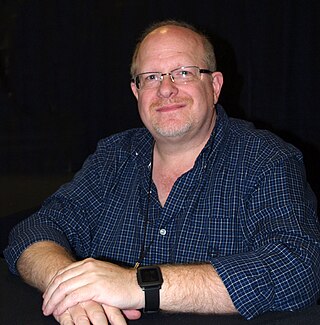
Mark Waid is an American comic book writer best known for his work on DC Comics titles The Flash, Kingdom Come and Superman: Birthright as well as his work on Captain America, Fantastic Four and Daredevil for Marvel. Other comics publishers he has done work for include Fantagraphics, Event, Top Cow, Dynamite, and Archie Comics.
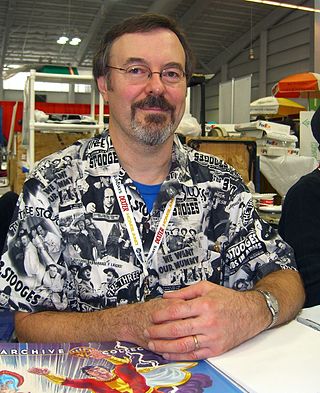
Jeremiah Joseph Ordway is an American writer, penciller, inker and painter of comic books.

Adam Kubert is an American comics artist known for his work for publishers such as Marvel Comics and DC Comics, including work on Action Comics, Astonishing Spider-Man & Wolverine, The Incredible Hulk, Ultimate Fantastic Four, Ultimate X-Men, and Wolverine.

Stephen "Steve" Epting is an American comics artist. He is best known for his work on The Avengers and Captain America for Marvel Comics.

Thomas Grummett is a Canadian comic book artist and penciller. He is best known for his work as penciller on titles such as The New Titans, The Adventures of Superman, Superboy, Power Company, Robin, New Thunderbolts and Heroes.

Carlos Pacheco Perujo was a Spanish comics penciller. After breaking into the European market doing cover work for Planeta De Agostini, he gained recognition doing work for Marvel UK, the England-based branch of Marvel Comics, for his work on the Spider-Man magazine Dark Guard. He then began doing work for the American-based Marvel and DC Comics, where he was one of the first Spanish-born artists to make a major impact in that country, attaining popularity for his work on Avengers Forever, JLA/JSA: Virtue and Vice, X-Men: Legacy, Fantastic Four, Green Lantern, and Captain America. He contributed to some high-profile storylines published by the Big Two, including 2009's "Final Crisis" at DC and 2013's "Age of Ultron" at Marvel.
Paul Neary was a British comic book artist, writer and editor.

Stuart Immonen is a Canadian comics artist. He is best known for his work on the Marvel Comics series Nextwave, Ultimate X-Men, The New Avengers, The Amazing Spider-Man, and Ultimate Spider-Man, the DC Comics series Action Comics and The Adventures of Superman, as well as for the original Millarworld series Empress, co-created with Mark Millar. His pencils are usually inked by Wade Von Grawbadger.
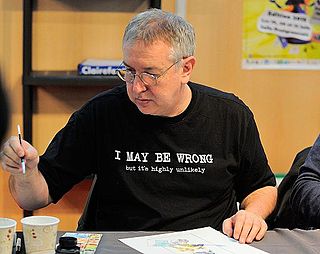
Barry Kitson is a British comic book artist.
Howard Porter is an American comic book artist from southern Connecticut.
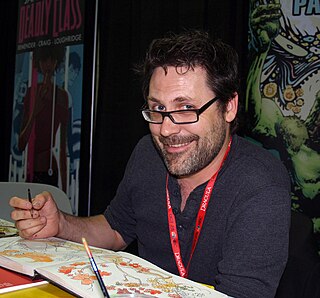
Yanick Paquette is a Canadian comic book artist. He has worked for Antarctic Press, Topps, Marvel, and DC Comics and since 1994.

Edward McGuinness is an American comic book artist and penciller, who has worked on books such as Superman, Superman/Batman, Deadpool, and Hulk. His pencil work is frequently inked by Dexter Vines, and as such, their cover work carries the stylized signature "EdEx". McGuinness frequent collaborator, writer Jeph Loeb, had characterized McGuinness' art style as incorporating elements of artists Jack Kirby and Arthur Adams.
References
- 1 2 "Bryan Hitch". Lambiek Comiclopedia. 5 September 2012. Archived from the original on 5 December 2012.
- 1 2 3 4 Ness, Alexander (15 September 2003). "City Of Heroes: A Conversation With Bryan Hitch". The Escapist. Archived from the original on 4 January 2023. Retrieved 4 January 2023.
- ↑ "National Comics Awards Results 2003". Down The Tubes. Archived from the original on 15 June 2006. Retrieved 15 April 2003.
- 1 2 3 4 5 6 7 8 Hitch, Bryan (2010). Bryan Hitch's Ultimate Comics Studio. Impact Books. ISBN 978-1600613272.
- 1 2 3 4 5 6 7 8 9 10 "NYCC: Bryan Hitch Spotlight". CBR.com. 20 April 2008. Archived from the original on 26 January 2021. Retrieved 4 January 2023.
- 1 2 3 Bryan Hitch at the Grand Comics Database
- 1 2 Cowsill, Alan (2010). "2000s". In Dolan, Hannah (ed.). DC Comics Year By Year A Visual Chronicle. London, United Kingdom: Dorling Kindersley. p. 297. ISBN 978-0-7566-6742-9.
Artist Bryan Hitch made full use of the book's extra-large format...Written by Mark Waid, Heaven's Ladder dealt with religion and the afterlife.
- ↑ Riesman, Abraham (26 April 2017). "Looking Back on The Ultimates, the Most Uncomfortable Superhero Story Ever Told". Vulture . Archived from the original on 29 April 2017. Retrieved 26 April 2017.
- ↑ "Ultimates". Comic Book Round Up. 2002. Archived from the original on 23 August 2017. Retrieved 4 January 2023.
- ↑ Ong Pang Kean, Benjamin (12 November 2006). "Hitch: Done with Ultimates 2 #13". Newsarama. Archived from the original on 13 December 2006. Retrieved 8 April 2008.
- ↑ "Ultimates 2 #1". Comic Book Round Up. December 2004. Archived from the original on 19 September 2021. Retrieved 5 January 2023.
- ↑ George, Richard (11 August 2007). "Millar And Hitch Are Fantastic". IGN. Archived from the original on 5 January 2023. Retrieved 5 January 2023.
- ↑ Boyle, Sean (12 February 2008). "Mark Millar: Tripping the Light Fantastic". Comics Bulletin. Archived from the original on 15 May 2008.
- ↑ Richards, Dave (11 August 2007). "WWC: Mark Millar is the New Fantastic Four-Man". CBR.com . Archived from the original on 21 May 2014. Retrieved 26 May 2013.
- 1 2 3 4 5 6 Encarnacion, Jonathan (12 August 2005). "The Concepts Behind Bryan Hitch". Silver Bullet Comics. Archived from the original on 28 November 2005. Retrieved 28 March 2008.
- 1 2 Diaz, Eric (4 June 2016). "Comics Relief: Dc Cancels Bryan Hitch's Justice League Of America". Nerdist. Archived from the original on 23 June 2021. Retrieved 4 January 2023.
- ↑ "Empire's Upcoming Comic Book Movie Issue". Superherohype.com. 27 September 2006. Archived from the original on 21 May 2014.
- ↑ Abrams, J. J. (2009). Star Trek (DVD commentary track). Paramount Pictures.
- ↑ "Stan Lee's Superhumans Videos". History Channel. Archived from the original on 9 March 2014.
- ↑ Phegley, Kiel (14 December 2012). "Bryan Hitch Returns To 'Age of Ultron' and 'America's Got Powers'". CBR.com. Archived from the original on 8 June 2021. Retrieved 4 January 2023.
- ↑ Logan, Michael (4 June 2012). "Exclusive First Look: The Walking Dead Comic Hits 100". TV Guide . Radnor Township, Delaware County, Pennsylvania. Archived from the original on 24 December 2013.
- ↑ Phegley, Kiel (19 November 2012). "Brian Bendis Prepares Age of Ultron For 2013". CBR.com . Archived from the original on 6 January 2013. Retrieved 21 January 2013.
- ↑ Rogers, Vaneta (6 January 2014). "Brad Meltzer Honors, Modernizes Batman's First Appearance in Detective Comics #27". Newsarama . Archived from the original on 21 May 2014.
Perhaps the most daunting task was given to Brad Meltzer and Bryan Hitch, who have created what DC is calling a 'modern-day retelling' of the first Batman story – the one in the original Detective Comics #27.
- ↑ Ching, Albert (18 November 2013). "Exclusive: Bryan Hitch Creates Some Real Heroes with Writing Debut". CBR.com . Archived from the original on 9 April 2014. Archive requires scrolldown
- ↑ Ching, Albert (6 February 2015). "Exclusive: First Details of New DC Series Including Hitch's Justice League of America and More". CBR.com . Archived from the original on 7 February 2015.
- ↑ Marston, George (30 March 2016). "Tony Daniel: Rebirth Justice League's 1st Arc Has 'Massive Consequences' For the League & the DCU". Newsarama. Archived from the original on 17 April 2016.
Tony Daniel is no stranger to relaunches at DC Comics...Now, with Rebirth, DC has tapped the veteran creator once again, this time pairing him with Bryan Hitch to relaunch Justice League.
- ↑ Arrant, Chris (31 July 2017). "Bryan Hitch Leaving DC's Justice League". Newsarama. Archived from the original on 11 August 2017.
Bryan Hitch has confirmed that he is leaving DC's Justice League title in October.
- ↑ Betancourt, David (14 March 2018). "Hawkman will return to his own series from DC Comics this summer". The Washington Post . Archived from the original on 14 March 2018. Retrieved 4 January 2023.
- ↑ Adams, Tim (14 March 2018). "DC's Hawkman Takes Flight in New Series From Venditti & Hitch". CBR.com . Archived from the original on 26 June 2018.
- ↑ Schedeen, Jesse (9 October 2019). "The Batman's Grave #1 Review". IGN. Archived from the original on 6 July 2021. Retrieved 4 January 2023.
- ↑ Dandeneau, Jim (13 January 2020). "Why The Batman's Grave Could Become a Modern Classic". Den of Geek. Archived from the original on 6 July 2022. Retrieved 4 January 2023.
- ↑ Spry, Jeff (28 September 2021). "Marvel's relaunched 'Venom' will take Eddie Brock & son (?!) Where they've 'never existed' before". SyFy. Archived from the original on 20 December 2021. Retrieved 4 January 2023.
- ↑ Doran, Michael (14 December 2022). "Venom ongoing gets a new artist in March". Newsarama. Archived from the original on 19 December 2022. Retrieved 4 January 2023.
- ↑ Marston, George (12 April 2023). "Mark Waid tells Superman: Birthright spiritual sequel and flashes back to the original Teen Titans in new DC titles". GamesRadar . Archived from the original on 9 December 2023. Retrieved 9 December 2023.
- ↑ "NYCC 2023: Ghost Machine Launches A Cooperative Media Company". Graphic Policy. 16 October 2023. Archived from the original on 19 October 2023. Retrieved 21 October 2023.
- ↑ Gustines, George Gene (12 October 2023). "A Comic Book Upstart Seeks to Shake Up the Industry". The New York Times . ISSN 0362-4331. Archived from the original on 14 October 2023. Retrieved 19 October 2023.
- ↑ Arrant, Chris (8 December 2023). "Marvel's Ultimates co-creator Bryan Hitch is calling it quits on Marvel, DC, and anything that he doesn't own himself". Popverse. Archived from the original on 9 December 2023. Retrieved 9 December 2023.
- 1 2 3 Johnston, Rich (12 October 2023). "Johns, Hitch, Frank, Fabok, Tomasi, Meltzer & Manapul's Ghost Machine". Bleeding Cool. Archived from the original on 21 October 2023. Retrieved 21 October 2023.
- ↑ Dominguez, Noah (13 October 2023). "Ghost Machine: Geoff Johns, Gary Frank and More Launch New Image Comics Imprint". SuperHero Hype. Archived from the original on 19 October 2023. Retrieved 19 October 2023.
- ↑ "Welcome to Ghost Machine". Ghost Machine Productions. 11 October 2023. Archived from the original on 21 October 2023. Retrieved 21 October 2023– via YouTube.
- ↑ Errico, Marcus (27 January 2015). "Filmmakers Break Down Fantastic Four Trailer, Reveal Most Viral-Ready Frame". Yahoo! Entertainment. Archived from the original on 26 July 2015.
- ↑ Hitch, Bryan (December 2009). "Bryan Hitch". Twitter. Archived from the original on 18 October 2014. Retrieved 5 January 2023.